Taghazout Beach
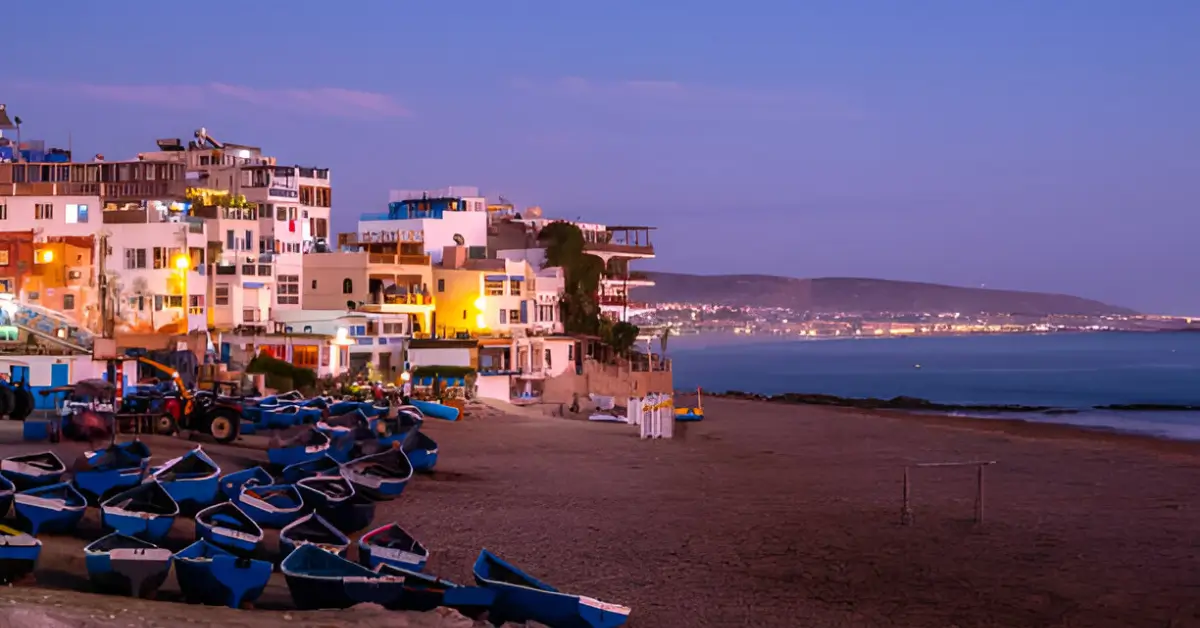
What is Taghazout Beach ?
Picture this: golden sands stretching for miles, perfect waves rolling in one after another, and a chill vibe that’ll make you want to extend your stay indefinitely. That’s Taghazout Beach for you a once-sleepy fishing village that’s become one of the world’s hottest surf spots without selling its soul.
What I love about Taghazout is how it’s managed to stay real. Sure, it’s gotten popular with the surf crowd, but you’ll still see local fishermen mending their nets while the scent of mouthwatering tagines fills the air. Colorful boats still dot the shoreline, and those charming whitewashed buildings haven’t been replaced by concrete monstrosities. It’s like Morocco decided to show off the perfect balance between traditional life and surf town cool.
What I’m Going to Tell You About
Look, I’m not here to overwhelm you with useless info. Instead, I’ll hook you up with everything you actually need to know:
- When to go (because timing is everything!)
- How to get there without pulling your hair out
- Cool stuff to do when your arms are too tired from paddling
- Where to crash – from dirt-cheap to “treat yo’self” options
- Day trips that are actually worth your time
When to Go to Taghazout
Let’s be real there’s no “bad” time to visit a place that gets over 300 sunny days a year, but your experience will definitely change with the seasons.
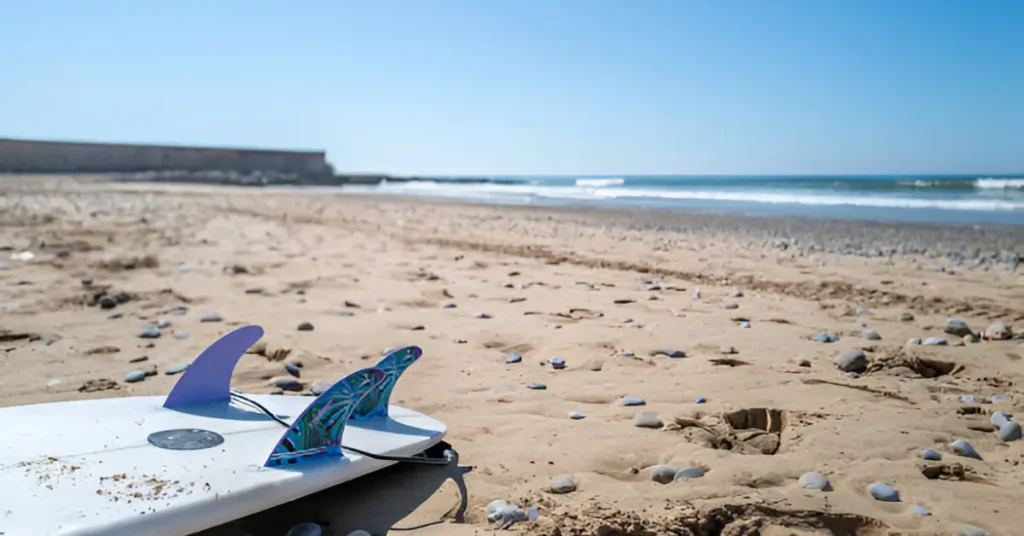
Surf Season (October–April)
If you’re serious about catching those legendary waves, this is your window. The Atlantic goes into overdrive between October and April, serving up consistent swells that make surfers weak at the knees. November through February? That’s the holy grail expect powerful waves regularly hitting 3-4 meters at spots like Anchor Point.
The weather’s still totally pleasant (think 18-23°C/64-73°F days), though you’ll want a wetsuit for the ocean. Fair warning: this is when every surf bro and their cousin descends on Taghazout, so expect to share waves and pay a bit more for your room.
Beach Bum Season (May–September)
Not a surfer? Or maybe you’re just learning? Summer might be your jam. The temperatures are perfect beach weather (25-30°C/77-86°F), and the gentler waves won’t try to kill you when you’re just trying to learn how to stand up on your board.
This is prime time for sunset yoga sessions, camel rides that’ll blow up your Instagram, and long dinners watching the sun sink into the Atlantic. The water warms up to a comfy 21-23°C (70-73°F), so you can ditch the wetsuit and just rock your board shorts or bikini.
The Sweet Spot (October/November & March/April)
Want the inside scoop? These in between months give you the best of both worlds decent waves without fighting through crowds of surf bros, plus temperatures that won’t leave you freezing or melting.
The locals call these the “Goldilocks months” not too hot, not too cold, not too crowded, but just right. And bonus: hotels often drop their prices during these shoulder seasons, so your wallet will thank you too.
Getting There & Where to Crash
How to Actually Get to Taghazout
For a world class surf spot, Taghazout is surprisingly easy to reach. Fly into Agadir–Al Massira Airport, which has direct flights from lots of European cities (or connect through Casablanca if you’re coming from further away).
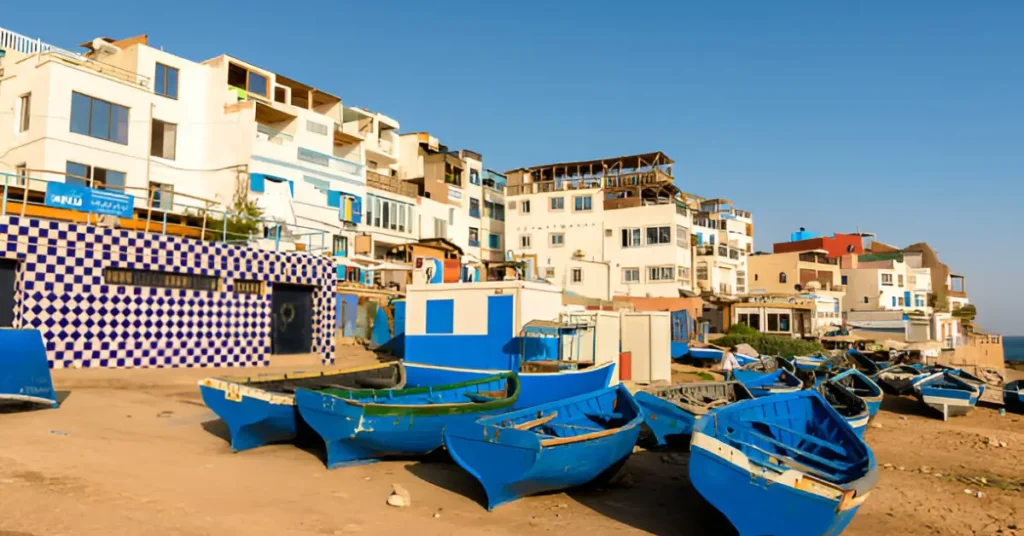
From there, you’re just 40 minutes north via the A7 highway (about 19 km). You’ve got options:
- Shared Shuttles: The budget-friendly move at 150-200 MAD per person. Most hotels and surf camps arrange these if you ask.
- Taxis: More convenient but pricier (300-400 MAD). Pro tip: ALWAYS negotiate the price before getting in, or you’ll suddenly discover that the meter is “broken.”
- Rental Cars: If you’re the independent type who wants to explore beyond Taghazout, this is your best bet. Just be prepared for, um, “creative” driving styles on Moroccan roads.
Once you’re in Taghazout, you can pretty much walk everywhere. The village isn’t exactly sprawling, which is part of its charm.
Where to Sleep
Taghazout has gone from having basically zero tourist accommodation to a whole spectrum of options:
Budget: Surf Hostels and Guesthouses
If you’re watching your dirhams, Taghazout’s hostels are a steal. For 100-150 MAD a night, you’ll get a dorm bed, usually a communal kitchen, and almost always a roof terrace where you can watch the sunset with fellow travelers swapping surf stories.
Local guesthouses offer private rooms from 250-400 MAD, often with a simple breakfast thrown in. The huge bonus here is getting to experience real Moroccan hospitality – expect the owner’s mom to try feeding you extra portions at breakfast because you “look too skinny.”
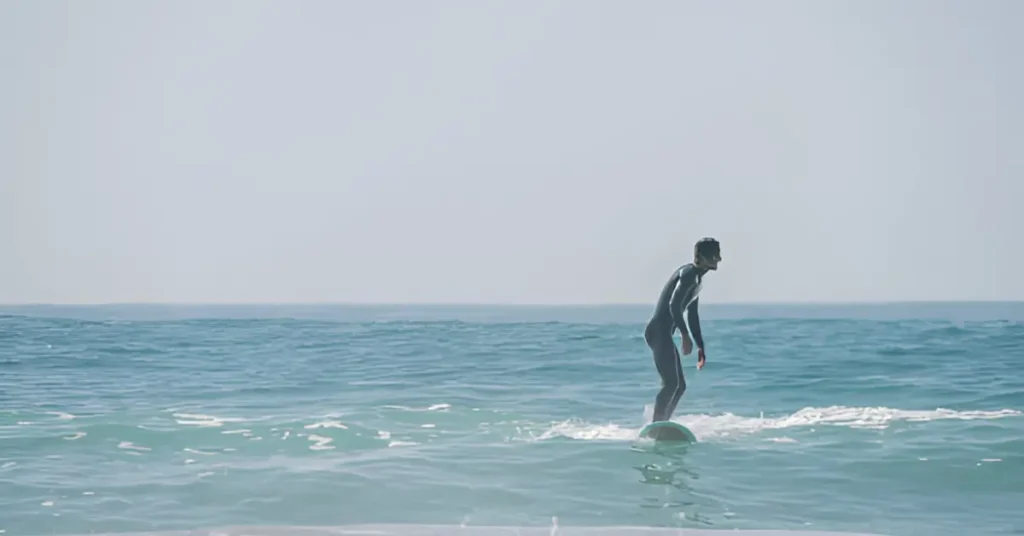
Mid-Range: Surf Camps That Feel Like Home
This is where Taghazout truly shines the surf camps here are legendary. For about 700-1200 MAD per night, you get a comfy bed, daily surf lessons, equipment rental, and usually meals included. They often have this perfect boho meets Morocco vibe with plenty of cushions, rugs, and panoramic ocean views.
The best part? Instant friends. These camps create ready made communities where you’ll meet people from all over the world who are just as stoked about surfing as you are. Even if you arrive solo, you’ll be part of a crew by dinner time.
Fancy Pants: Seafront Resorts
Got some cash to splash? The newer Taghazout Bay development has brought in some serious luxury. Starting around 1500 MAD per night, you can get infinity pools overlooking the Atlantic, spa treatments that’ll make you forget what stress even is, and restaurants serving everything from traditional Moroccan to international cuisine.
These spots are perfect if you want to combine surfing with a proper vacation or if you’re dragging along a partner who thinks “roughing it” means no room service.
Cool Stuff to Do in Taghazout
Surfing & Water Sports (Obviously)
Let’s be honest – the waves are why most people come to Taghazout. The coastline here is ridiculous, with over 20 different breaks packed into a 20km stretch:
The Famous Breaks
If you know your way around a surfboard, these spots will make your heart race:
- Anchor Point: The crown jewel – a right-hand point break that, on good days, gives you rides so long your legs will be burning. When it’s pumping, you might catch waves that run for 500 meters. Not even kidding.
- Killer Point: Despite the terrifying name (it came from orcas spotted there, not from surfers dying!), this spot delivers powerful waves with hollow sections that’ll give you the barrel ride of your dreams.
- Panorama Point: Slightly more forgiving but still challenging enough to keep it interesting. The views alone are worth paddling out for.
Beginner-Friendly Spots (Because We All Start Somewhere)
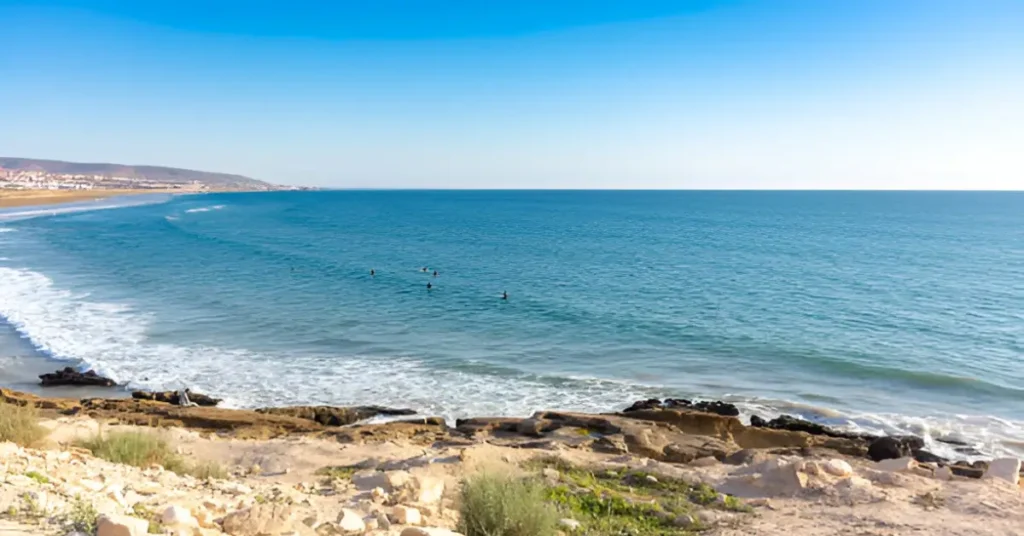
Don’t worry if you can barely stand up on a board – Taghazout’s got you covered:
- Panorama Beach: A sandy-bottom break where falling doesn’t mean getting scraped across rocks.
- Hash Point: Despite sounding like something your college roommate was into, this is actually a mellow right-hander perfect for improving your skills.
- Crocs/La Source: Gentle whitewash that’s ideal for your very first lessons.
Surf schools are everywhere, with lessons starting around 250 MAD. The instructors are usually multilingual surf bums who decided office life wasn’t for them, and their enthusiasm is infectious.
Yoga & Hammams (Because Your Muscles Will Need It)
After a few days of surfing, your body will be begging for mercy. Luckily, Taghazout has embraced wellness culture with open arms:
Yoga That Doesn’t Take Itself Too Seriously
Morning and sunset yoga sessions have become a Taghazout staple. There’s something magical about doing a sun salutation while actually watching the sun rise over the Atlantic. Sessions typically cost 80-150 MAD, and many surf camps include them in their packages.
The best part? The yoga scene here isn’t pretentious. Nobody cares if you can’t touch your toes or if your downward dog looks more like a confused giraffe.
Hammams That Will Change Your Life
Listen, you haven’t truly lived until you’ve experienced a Moroccan hammam. These traditional steam baths involve:
- Getting steamed like a dumpling
- Being scrubbed within an inch of your life (you’ll be horrified by how much dead skin comes off)
- Getting slathered in clay
- Finishing with an argan oil massage that’ll make you melt
The whole experience costs 200-400 MAD and is worth every dirham. Fair warning: in traditional hammams, modesty goes out the window, so embrace the awkwardness and remember everyone’s too focused on their own experience to judge yours.
Land Adventures When You Need a Break from the Ocean
When your fingers look like prunes from too much time in the water:
Camel & Horse Rides That Aren’t Just Tourist Traps
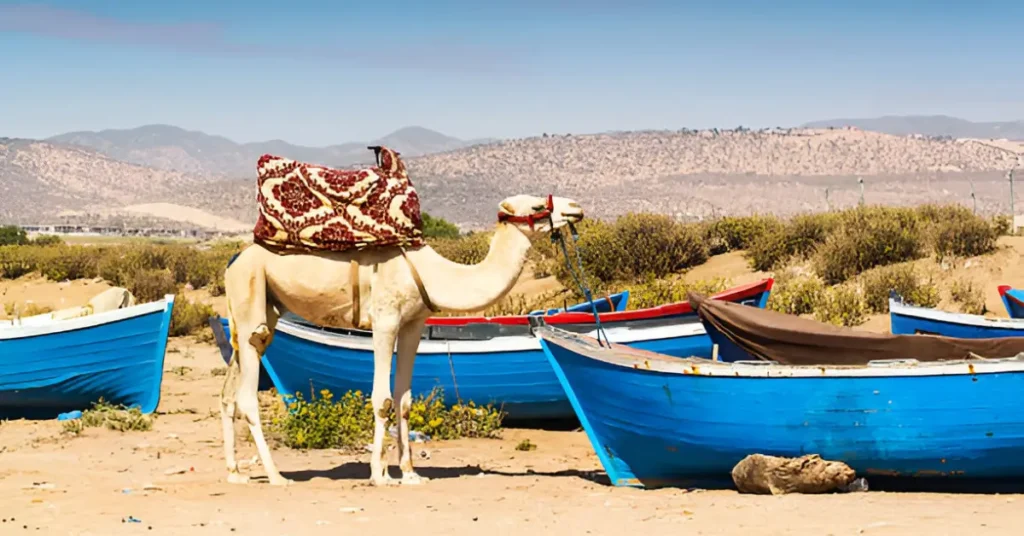
Yes, riding a camel along the beach at sunset is touristy. Yes, you should do it anyway because it’s actually awesome. For 150-250 MAD, you’ll get an hour of bouncing along on these bizarre animals with permanent smirks on their faces.
If you prefer horses, those are available too and can take you to places vehicles can’t reach – through argan forests and hidden beaches that make you feel like a proper explorer.
Quad-Biking That’ll Make You Feel Like a Kid Again
Let’s be real – ripping across beaches, riverbeds, and trails on a quad bike is just pure fun. Half-day tours run 600-800 MAD and cater to all experience levels. Some tours include sandboarding on nearby dunes, which is basically snowboarding but with sand in places you didn’t know sand could reach.
Local Culture & Food (Because You Gotta Eat)
Taghazout isn’t just about the beach life:
Markets That’ll Test Your Bargaining Skills
While Taghazout has its own small markets, the real deal is in nearby Agadir. Wednesday’s souk is sensory overload in the best way – mountains of spices, colorful textiles, and vendors who consider haggling an Olympic sport.
My advice? Decide your maximum price before starting negotiations, offer about 40% of that, and work your way up slowly. And remember – keep a sense of humor! It’s supposed to be fun, not stressful.
Shopping That Won’t Break the Bank
In Taghazout itself, you’ll find an increasing number of artisan shops selling:
- Leather goods that smell amazing
- Berber carpets that somehow won’t fit in your suitcase but you’ll buy anyway
- Argan oil products (the real stuff, not the fake stuff you find at home)
- Surf-themed crafts that blend Moroccan tradition with board culture
Food That’ll Ruin You for Life
Taghazout’s food scene perfectly reflects its dual identity:
- Beachfront seafood spots where today’s catch goes straight from boat to grill
- Traditional tagine places where the same stew has been simmering since morning
- Hipster cafés serving avocado toast and açaí bowls to Instagram-happy visitors
Don’t miss the fish chermoula (fish marinated in herbs and spices that’ll make you question everything you thought you knew about seafood) and zaalouk (smoky eggplant salad that’s basically babaganoush’s cooler Moroccan cousin). Most meals at local spots will set you back just 50-80 MAD.
Day Trips Worth Getting Out of Bed For
When you’ve surfed all the breaks (or just need a change of scenery):
Paradise Valley: Nature’s Perfect Swimming Pools
Just 45 minutes inland, Paradise Valley is exactly what it sounds like – a series of emerald pools carved into smooth rock formations, surrounded by palm trees and mountains. It’s like Mother Nature designed the perfect swimming spot.
The hike to reach the best pools isn’t too challenging, but wear proper shoes (not flip-flops – learn from my mistakes). Combine it with a visit to an argan oil cooperative where local women will show you how they make the “liquid gold” that makes Moroccan hair so enviably shiny.
Legzira Beach: That Sunset Spot You’ve Seen on Instagram
About 2.5 hours south, the red stone arches of Legzira Beach are Morocco’s answer to Instagram fame. Sadly, one collapsed in 2016 (nature has no respect for social media), but the remaining formation is still spectacular, especially at sunset when it glows like it’s on fire.
Nearby Sidi Ifni feels like stepping into a time warp with its blue-and-white Art Deco buildings – a fascinating contrast to Taghazout’s more rustic vibe.
Essaouira: For Game of Thrones Fans and Wind Lovers
If you’re ambitious (and don’t mind a 3-hour drive), Essaouira makes for an epic day trip. This walled city by the sea has mad Game of Thrones vibes with its impressive ramparts, bustling fishing harbor, and winding blue-doored medina.
The strong winds that plague swimmers here are a blessing for kitesurfers, so if regular surfing isn’t thrilling enough for you, this is your chance to literally fly over the waves.
That Fancy Taghazout Bay Development Everyone’s Talking About
You might hear locals debate the merits of the massive Taghazout Bay project that’s been reshaping the area:
What’s the Big Deal?
Part of Morocco’s “let’s boost tourism” master plan, Taghazout Bay spans a whopping 615 hectares of prime coastal real estate. The vision is to create a high-end destination with thousands of tourist beds without turning the place into Cancún (thank goodness).
What They’ve Built
The development includes:
- A golf course with ocean views (because apparently some people go to surf paradise to… golf?)
- A swanky marina for people with boats (or people who like looking at boats)
- A purpose-built shopping area designed to look like a traditional medina
- Sports academies focused on water sports
- Beach clubs with pools (yes, pools right next to the ocean – I don’t get it either)
Is It Ruining Taghazout?
Here’s the surprising thing – unlike many development projects that steamroll local character, Taghazout Bay has been relatively respectful. They’ve preserved green spaces, implemented decent water management systems, and created jobs for locals.
Most long-timers agree that while change is inevitable, Taghazout has managed to keep its soul intact despite the influx of investment. The original village still feels authentic, even as luxury resorts sprout up along the coastline.
Practical Stuff You Actually Need to Know
Money Matters
How much cash should you bring? It depends on your style:
- Backpacker life: 300-500 MAD daily will cover a hostel bed, street food, and cheap transport
- Comfortable traveler: Budget 700-1200 MAD daily for surf camps, restaurant meals, and activities
- Luxury seeker: 1500+ MAD daily for resort stays, fine dining, and private excursions
Morocco uses dirhams (MAD), and while there are ATMs in Taghazout village, always have some cash on hand – many small businesses still give you that “card machine broken” look when you try to pay electronically.
Language & Staying Connected
No need to stress about language barriers. Tourism has made English widely spoken, but knowing a few key phrases makes locals smile:
- “Shukran” (thank you) will get you far
- “Salam alaikum” (hello/peace be upon you) shows respect
- “La shukran” (no thank you) helps with persistent vendors
For Instagram addicts, Wi-Fi is available pretty much everywhere in Taghazout, though speeds vary from “surprisingly decent” to “is this dial-up?” For reliable connectivity, grab a local SIM card (Maroc Telecom, Orange, or Inwi) at the airport or in Agadir. They’re cheap and will save you from international roaming fees that could fund another vacation.
Cultural Do’s and Don’ts
Taghazout is pretty relaxed by Moroccan standards, but a little cultural awareness goes a long way:
- Cover up when you’re not at the beach – yes, it’s hot, but showing too much skin in town is disrespectful
- Ask before taking photos of locals – how would you feel if strangers constantly snapped your picture?
- If visiting during Ramadan, be discreet about eating and drinking in public during daylight hours
As for water safety:
- Always check conditions with locals before paddling out – those perfect-looking waves might have hidden rip currents
- Learn which zones are for swimmers and which are for surfers – board-to-head collisions aren’t a fun vacation memory
- Respect the surf hierarchy at popular breaks – don’t be that person who drops in on everyone’s waves
Why You Should Book That Ticket Right Now
There’s something magical about Taghazout that’s hard to put into words. It’s where traditional Morocco meets international surf culture, where adventure sports happen alongside serious relaxation, and where development hasn’t killed the authentic vibe that made the place special to begin with.
Whether you’re waking up at dawn to catch perfect waves at Anchor Point, lounging at a café with mint tea watching fishermen haul in their catches, or exploring argan-studded hillsides on a mountain bike, Taghazout offers experiences that feel both exotic and welcoming.
The best part? It’s still flying under the radar compared to more famous Moroccan destinations. Go now, before everyone else discovers it too.
Questions You’re Probably Asking
“I can’t surf to save my life. Will I be bored?” Not a chance! While surfing put Taghazout on the map, non-surfers have plenty to enjoy – yoga, wellness, cultural experiences, and let’s be honest, sometimes just watching surfers while enjoying a beachfront coffee is entertainment enough. Plus, if you’ve ever wanted to learn, the gentle beach breaks and affordable lessons make this the perfect place to start.
“Can I fit Taghazout into a bigger Morocco trip?” Absolutely! Many visitors combine Taghazout with other Moroccan highlights. Marrakech is just 3-4 hours away by car, making it an easy addition. If you’re dreaming of desert adventures, places like Merzouga require a bit more travel time (think two-day journey), but the contrast between surfing waves one day and riding camels over sand dunes the next is pretty epic.
“How much will surf lessons set me back?” Individual lessons run about 250-400 MAD for a two-hour session, equipment included. Multi-day packages are the better deal though – weeklong programs (daily lessons, gear, and sometimes accommodation) start around 2500 MAD. Group lessons save you some dirhams, while private coaching costs more but means personalized attention. Even if you’re a complete beginner, after a week in Taghazout, you’ll be standing up and catching waves
